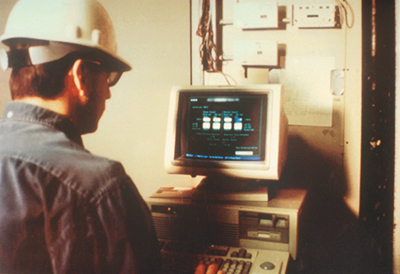Sensors for Environmental Control
A particularly productive source of spinoff products and processes is the Small Business Innovation Research (SBIR) program, which was established by Congress with two objectives: to increase participation of small businesses in federal high technology R&D activities, and to stimulate conversion of government-funded research into commercial applications.
NASA's SBIR program has been eminently successful. It provides NASA an additional source-beyond traditional aerospace companies-of R&D talent and innovative thought. Hundreds of new systems and components that advance NASA's capabilities have emerged from the SBIR program. On the other side of the coin, NASA SBIR contracts give small businesses opportunities to hone their R&D skills and expand their technological capabilities, and in many cases an SBIR assignment leads to a contractor's development, with private capital, of a commercially useful product or process.
An example of environment-related research that led to commercialization of new types of sensors is the SBIR collaboration of Kennedy Space Center (KSC) with GEO-CENTERS, Inc., Newton Centre, Massachusetts. GEO-CENTERS is a company dedicated to basic and application-oriented R&D over a broad spectrum of technological disciplines. The company has special capabilities in designing fiber optic sensors for such applications as measurement and characterization of industrial processes, remote sensing of chemical/biological hazards, and environmental monitoring.
KSC's initial SBIR contract with GEO-CENTERS (1990) sought development of an instrument for use in space life support research (investigation of the air/water recycling potential of certain plants). An important element of such research is accurate measurement of the hydroponic culture's pH factor, an indication of the acidity or alkalinity level of a solution. NASA was interested in an advanced type of sensor known as an "optrode," the optical-based equivalent of the glass pH electrode. A series of optrodes would provide information about maintaining the proper conditions for the plants' survival in a "space greenhouse."
Over a two-year span, GEO-CENTERS successfully developed an optrode for NASA use and, since the instrument clearly had strong commercial potential, embarked on development of a PC Based pH Monitoring System for industrial use.
Now commercially available, the system employs a proprietary fiber optic sensor (the optrode) to enable long term continuous monitoring of the pH level of fluids in both standing and flowing conditions. In addition to the optrode, the system includes an opto-electronic (printed circuit) board, equipped with light sensors and detectors, that fits into a standard desktop computer; and a fiber optic cable connecting the circuit board and optrode through which communications (light signals) are relayed. The optoelectronics board supplies energy to the optrode and converts the optrode's optical signals to electrical signals. System software provides pH display, data logging, calibration and diagnostic functions.
A typical application is monitoring the pH of an industrial process stream to assure that the pH values of the effluent discharged from the plant are within the acceptable range specified by the Environmental Protection Agency. Normally, groundwater has a pH of 5.5 to 7.5; when used in chemical processing, the pH level can fall outside the normal limits and become harmful to fish and wildlife. Therefore, the pH level of a process stream must be continuously monitored to verify acceptability and, if it is not in compliance, it must be restored to the acceptable range.
GEO-CENTERS literature cites a number of advantages of the fiber optic pH monitor: low maintenance, long term calibration stability, high resistance to biological/chemical fouling, and immunity to electromagnetic interference caused by radio waves, lightning, motors or generators, because the system is optically based rather than electrically based. In addition, the optrode can operate in solutions with very low conductivity, an important factor in the measurement of very clean-hence low conductivity-boiler water at power plants.
In 1993, when development of the commercial pH sensor was in progress, KSC awarded GEO-CENTERS another SBIR contract related to space recycling research, this one for a sensor capable of continuously monitoring dissolved ammonia in a bioreactor and an aquaculture. This development was successfully accomplished in 1995 and commercialized with the first deliveries late in that year.
The ammonia sensor employs the same general configuration as the pH sensor, including a replaceable sensing element and the computer-compatible opto-electronic board. The application, however, is different: it is intended for monitoring bioreactors rather than process streams. Bioreactors are complex systems containing biological components (bacteria, yeast, mammalian cells). Used to synthesize compounds, such as pharmaceuticals, bioreactors must maintain colonies of living organisms whose density and health determine the ultimate productivity of the reactor. The ammonia concentration-along with pH-is one of the important variables that must be controlled to assure proper conditions for maintaining a colony. There is, says GEO-CENTERS, no other means available for continuously monitoring ammonia levels in a bioreactor and the company sees a significant potential market for its ammonia sensor.

A plant technician monitors an industrial process stream to assure that the effluent water's pH level is in compliance with environmental regulations. Recently introduced to the commercial market by GEOCENTERS, Inc. the pH sensing system exemplifies the broad range of spinoff products emerging from the NASA Small Business Innovation Research program.













